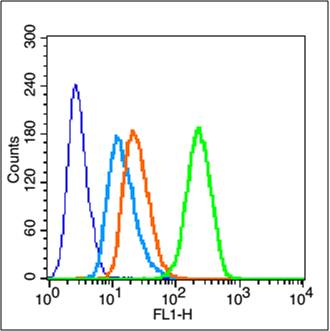
Rabbit Anti-CA153 antibody
Breast carcinoma associated antigen DF3; Breast carcinoma associated antigen DF3; Breast carcinoma-associated antigen DF3; CA 15 3; CA 15-3; CA15 3; CA15 3 antigen; CA15.3; Cancer antigen 15-3; Carcinoma associated mucin; Carcinoma associated mucin; Carci
View History [Clear]
Details
Product Name CA153 Chinese Name 粘蛋白-1抗体 Alias Breast carcinoma associated antigen DF3; Breast carcinoma associated antigen DF3; Breast carcinoma-associated antigen DF3; CA 15 3; CA 15-3; CA15 3; CA15 3 antigen; CA15.3; Cancer antigen 15-3; Carcinoma associated mucin; Carcinoma associated mucin; Carcinoma-associated mucin; CD 227; CD227; CD227; CD227 antigen; DF3 antigen; DF3 antigen; EMA; EMA; Episialin; Episialin; Epithelial membrane antigen; Epithelial membrane antigen; Epithelial mucin tandem repeat sequence; H23 antigen; H23 antigen; H23AG; H23AG; HGNC:7508; KL 6; KL-6; KL6; Krebs von den Lungen-6; MAM 6; MAM6; MUC 1; MUC 1; MUC-1; MUC-1/SEC; MUC-1/X; MUC1; MUC1-alpha; MUC1-beta; MUC1-CT; MUC1-NT; MUC1/ZD; MUC1_HUMAN; Mucin 1; Mucin 1 precursor; Mucin 1 transmembrane; Mucin-1 subunit beta; Mucin1; Mucin1; Peanut reactive urinary mucin; Peanut reactive urinary mucin; Peanut-reactive urinary mucin; PEM; PEMT; PEMT; Polymorphic epithelial mucin; Polymorphic epithelial mucin; PUM; PUM; Tumor associated epithelial membrane antigen; Tumor associated epithelial membrane antigen; Tumor associated epithelial mucin; Tumor associated mucin; Tumor associated mucin; Tumor-associated epithelial membrane antigen; Tumor-associated mucin. literatures Research Area Tumour Cell biology t-lymphocyte epithelial cells Immunogen Species Rabbit Clonality Polyclonal React Species Human, Applications ELISA=1:5000-10000
not yet tested in other applications.
optimal dilutions/concentrations should be determined by the end user.Theoretical molecular weight 138kDa Cellular localization The nucleus cytoplasmic The cell membrane Secretory protein Form Liquid Concentration 1mg/ml immunogen KLH conjugated synthetic peptide derived from human CA153/EMA/MUC1: 941-1040/1255 <Extracellular> Lsotype IgG Purification affinity purified by Protein A Buffer Solution 0.01M TBS(pH7.4) with 1% BSA, 0.03% Proclin300 and 50% Glycerol. Storage Shipped at 4℃. Store at -20 °C for one year. Avoid repeated freeze/thaw cycles. Attention This product as supplied is intended for research use only, not for use in human, therapeutic or diagnostic applications. PubMed PubMed Product Detail MUC1 is a large cell surface mucin glycoprotein expressed by most glandular and ductal epithelial cells and some hematopoietic cell lineages. It is expressed on most secretory epithelium, including mammary gland and some hematopoietic cells. It is expressed abundantly in lactating mammary glands and overexpressed abundantly in >90% breast carcinomas and metastases. Transgenic MUC1 has been shown to associate with all four cebB receptors and localize with erbB1 (EGFR) in lactating glands. The MUC1 gene contains seven exons and produces several different alternatively spliced variants. The major expressed form of MUC1 uses all seven exons and is a type 1 transmembrane protein with a large extracellular tandem repeat domain. The tandem repeat domain is highly O glycosylated and alterations in glycosylation have been shown in epithelial cancer cells.
Subunit:
Contains 1 SEA domain.
Subcellular Location:
Secreted; Cell membrane. Cytoplasm. Nucleus. On EGF and PDGFRB stimulation, transported to the nucleus through interaction with CTNNB1, a process which is stimulated by phosphorylation. On HRG stimulation, colocalizes with JUP/gamma-catenin at the nucleus and Apical cell membrane. Exclusively located in the apical domain of the plasma membrane of highly polarized epithelial cells. After endocytosis, internalized and recycled to the cell membrane. Located to microvilli and to the tips of long filopodial protusions.
Tissue Specificity:
Expressed on the apical surface of epithelial cells, especially of airway passages, breast and uterus. Also expressed in activated and unactivated T-cells. Overexpressed in epithelial tumors, such as breast or ovarian cancer and also in non-epithelial tumor cells. Isoform 7 is expressed in tumor cells only.
SWISS:
P15941
Gene ID:
4582
Database links:Entrez Gene: 4582 Human
Entrez Gene: 17829 Mouse
Omim: 158340 Human
SwissProt: P15941 Human
SwissProt: Q02496 Mouse
Unigene: 89603 Human
Unigene: 16193 Mouse
CA153为高分子glycoprotein,是乳腺癌Maker之一,其表达的量与乳腺癌的分化程度及雌激素受体高低有关联。近年来,很多学者研究认为:在人的很多种恶性Tumour中都有CA15-3的不同表达。Product Picture
Primary Antibody (green line): Rabbit Anti-CA153 antibody (SL4763R),Dilution: 0.2μg /10^6 cells;
Isotype Control Antibody (orange line): Rabbit IgG .
Secondary Antibody (white blue line): Goat anti-rabbit IgG-FITC,Dilution: 1μg /test.
References (0)
No References
Bought notes(bought amounts latest0)
No one bought this product
User Comment(Total0User Comment Num)
- No comment



 +86 571 56623320
+86 571 56623320
 +86 18668110335
+86 18668110335

